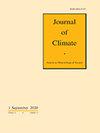The Role of the Aleutian Low in the Relationship between Spring Pacific Meridional Mode and Following ENSO
IF 4
2区 地球科学
Q1 METEOROLOGY & ATMOSPHERIC SCIENCES
引用次数: 0
Abstract
Abstract The spring Pacific meridional mode (PMM) is an important precursor of El Niño–Southern Oscillation (ENSO). However, recent studies reported that only about half of the spring PMM events were followed by ENSO events. This study examines the role of internal climate variability in modulating the impact of PMM on ENSO using 100-member ensemble simulations of the Max Planck Institute Earth System Model (MPI-ESM). The relationship between spring PMM and following winter ENSO shows a large spread among the 100 members. The variation of spring Aleutian low (AL) intensity is identified to be an important factor modulating the PMM–ENSO relation. The spring AL affects the PMM–ENSO relationship by modifying PMM-generated low-level zonal wind anomalies over the tropical western Pacific. The strengthening of the spring AL is accompanied by westerly wind anomalies over the midlatitude northwestern Pacific, leading to sea surface temperature (SST) cooling there via an enhancement of upward surface heat flux. This results in increased meridional SST gradient and leads to northerly wind anomalies over the subtropical northwestern Pacific, which turn to surface westerly wind anomalies after reaching the equatorial western Pacific due to the conservation of potential vorticity. Thus, the low-level westerly (easterly) wind anomalies over the tropical western Pacific associated with the positive (negative) spring PMM were strengthened (weakened), which further contributes to an enhanced (a weakened) PMM–ENSO relation. The mechanism for the modulation of the AL on the spring PMM–ENSO relationship is verified by a set of AGCM simulations. This study suggests that the condition of the spring AL should be considered when predicting ENSO on the basis of the PMM. Significance Statement Spring Pacific meridional mode (PMM) is a predictor of ENSO, but not all spring PMM events are accompanied by the occurrence of ENSO events. This study aims to explore the influence of internal climate variability on the relationship between spring PMM and following ENSO. It is revealed that the Aleutian low exerts a crucial modulation on the spring PMM–ENSO relationship. The underlying physical mechanisms for the impact of the Aleutian low on the relationship between spring PMM and ENSO are further examined. The results of this study have important implications for improving the prediction of ENSO.阿留申低地在春季太平洋经向模式与后续厄尔尼诺/南方涛动关系中的作用
摘要 春季太平洋经向模式(PMM)是厄尔尼诺-南方涛动(ENSO)的重要前兆。然而,最近的研究报告表明,只有大约一半的春季经向模式事件之后出现了厄尔尼诺/南方涛动事件。本研究利用马克斯-普朗克研究所地球系统模式(MPI-ESM)的 100 个成员集合模拟,研究了内部气候变率在调节 PMM 对厄尔尼诺/南方涛动影响中的作用。春季 PMM 与次年冬季厄尔尼诺/南方涛动之间的关系在 100 个成员中表现出很大的差异。春季阿留申低地(AL)强度的变化被认为是调节 PMM-ENSO 关系的一个重要因素。春季阿留申低压通过改变 PMM 产生的热带西太平洋低层带状风异常来影响 PMM-ENSO 关系。春季 AL 的增强伴随着西北太平洋中纬度上空的西风异常,通过增强向上的表面热通量导致那里的海面温度(SST)冷却。这导致经向海温梯度增大,并导致西北太平洋副热带上空的偏北风异常,由于位涡守恒,到达赤道西太平洋后,偏北风异常会转变为海面西风异常。因此,热带西太平洋上空与春季 PMM 正(负)相关的低层西风(东风)异常增强(减弱)了,这进一步促成了 PMM-ENSO 关系的增强(减弱)。一组 AGCM 模拟验证了 AL 对春季 PMM-ENSO 关系的调节机制。这项研究表明,在根据PMM预测厄尔尼诺/南方涛动时,应考虑春季AL的状况。意义声明 春季太平洋经向模式(PMM)是厄尔尼诺/南方涛动的预报因子,但并非所有春季 PMM 事件都伴随着厄尔尼诺/南方涛动事件的发生。本研究旨在探讨内部气候变率对春季经向模式与后续厄尔尼诺/南方涛动之间关系的影响。研究发现,阿留申低气压对春季 PMM 与 ENSO 的关系起着至关重要的调节作用。研究还进一步探讨了阿留申低纬度对春季 PMM 与厄尔尼诺/南方涛动关系影响的基本物理机制。研究结果对改进厄尔尼诺/南方涛动的预测具有重要意义。
本文章由计算机程序翻译,如有差异,请以英文原文为准。
求助全文
约1分钟内获得全文
求助全文
来源期刊

Journal of Climate
地学-气象与大气科学
CiteScore
9.30
自引率
14.30%
发文量
490
审稿时长
7.5 months
期刊介绍:
The Journal of Climate (JCLI) (ISSN: 0894-8755; eISSN: 1520-0442) publishes research that advances basic understanding of the dynamics and physics of the climate system on large spatial scales, including variability of the atmosphere, oceans, land surface, and cryosphere; past, present, and projected future changes in the climate system; and climate simulation and prediction.
 求助内容:
求助内容: 应助结果提醒方式:
应助结果提醒方式:


